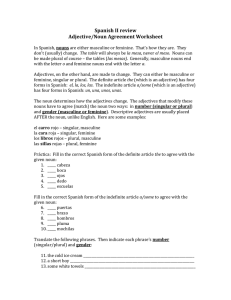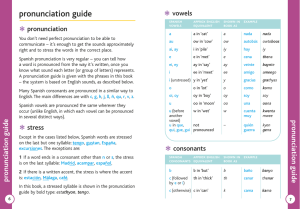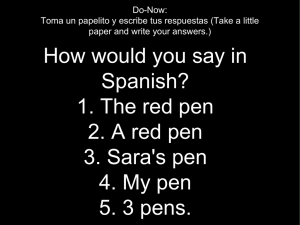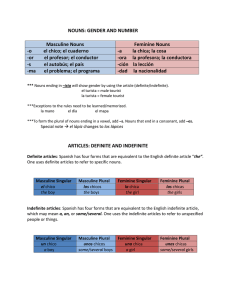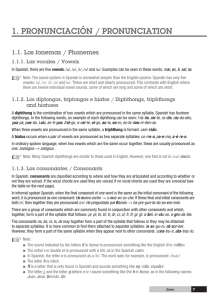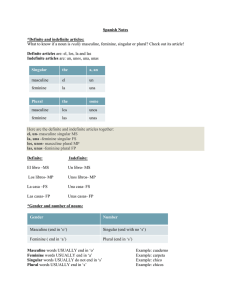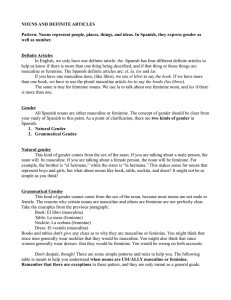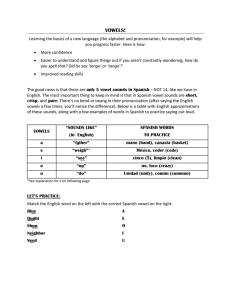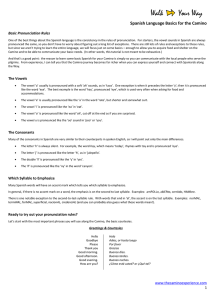1. PRONUNCIACIÓN / PRONUNCIATION
Anuncio
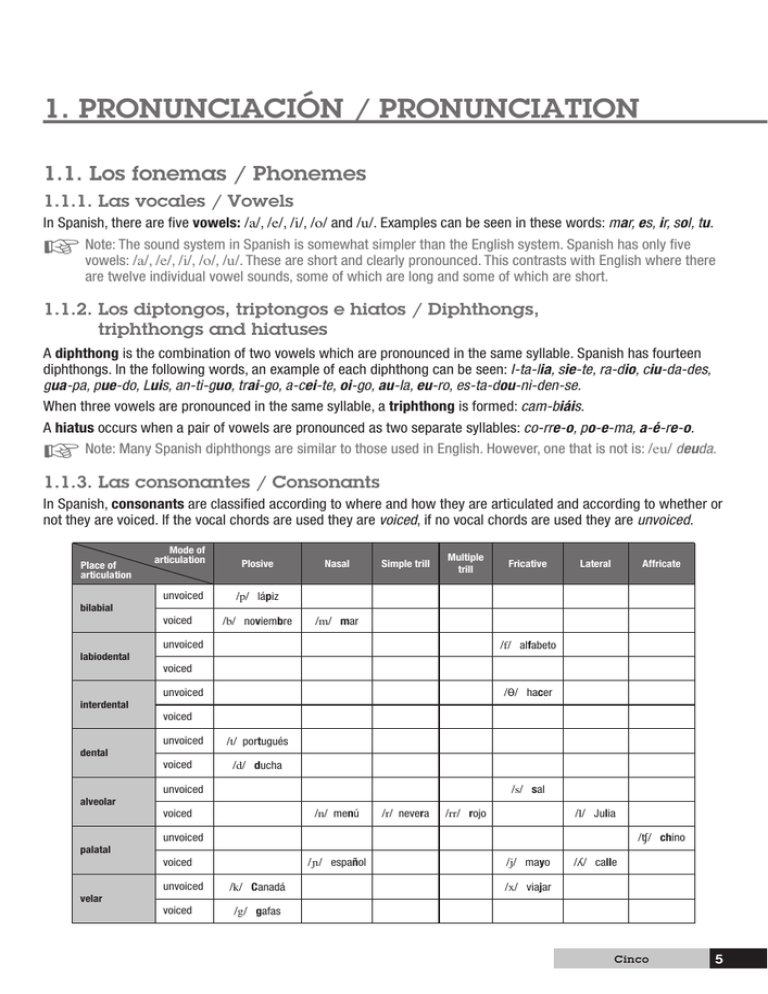
1. PRONUNCIACIÓN / PRONUNCIATION 1.1. Los fonemas / Phonemes 1.1.1. Las vocales / Vowels In Spanish, there are five vowels: /a/, /e/, /i/, /o/ and /u/. Examples can be seen in these words: mar, es, ir, sol, tu. The sound system in Spanish is somewhat simpler than the English system. Spanish has only five ☞☞Note: vowels: /a/, /e/, /i/, /o/, /u/. These are short and clearly pronounced. This contrasts with English where there are twelve individual vowel sounds, some of which are long and some of which are short. 1.1.2. L os diptongos, triptongos e hiatos / Diphthongs, triphthongs and hiatuses A diphthong is the combination of two vowels which are pronounced in the same syllable. Spanish has fourteen diphthongs. In the following words, an example of each diphthong can be seen: I-ta-lia, sie-te, ra-dio, ciu-da-des, gua-pa, pue-do, Luis, an-ti-guo, trai-go, a-cei-te, oi-go, au-la, eu-ro, es-ta-dou-ni-den-se. When three vowels are pronounced in the same syllable, a triphthong is formed: cam-biáis. A hiatus occurs when a pair of vowels are pronounced as two separate syllables: co-rre-o, po-e-ma, a-é-re-o. ☞☞Note: Many Spanish diphthongs are similar to those used in English. However, one that is not is: /eu/ deuda. 1.1.3. Las consonantes / Consonants In Spanish, consonants are classified according to where and how they are articulated and according to whether or not they are voiced. If the vocal chords are used they are voiced, if no vocal chords are used they are unvoiced. Place of articulation bilabial Mode of articulation unvoiced voiced labiodental Plosive Nasal Simple trill Multiple trill Fricative Lateral Affricate /p/ lápiz /b/ noviembre /m/ mar unvoiced /f/ alfabeto voiced unvoiced interdental dental /T/ hacer voiced unvoiced voiced /t/ portugués /d/ ducha unvoiced alveolar /s/ sal voiced /n/ menú /r/ nevera /rr/ rojo /l/ Julia // chino unvoiced palatal velar voiced unvoiced voiced /|/ español /k/ Canadá // mayo /ʎ/ calle /x/ viajar /g/ gafas Cinco 5 ☞☞Note: The sound indicated by the letters ll in llamar is pronounced something like the English lli in million. ● ● The ● In ● The ● Ñ initial r or double rr is pronounced with a trill, as in the Spanish carro. Spanish, the letter v is pronounced as a /b/. The word vale, for example, is pronounced: /bale/. letter h is silent. is a letter that is only found in Spanish and sounds something like ny: niña, español. letter j, and the letter g (before e or i) sounds something like the h in horse, as in the following names: Juan, José, Germán, Gil. ● The 1.2. La sílaba / Syllables A syllable consists of a sound or a group of sounds which are pronounced at one short time. They can be considered as the phonetic building blocks of words. In Spanish, each syllable has at least one vowel, which is the nucleus, and there may also be consonant sounds before or after the nucleus. The most frequent combinations are: ● consonant 1 vowel: ca-sa. ● consonant 1 vowel 1 consonant: can-tar. ● consonant (p, b, f, g, c, d, t ) 1 consonant (l, r ) 1 vowel: nom-bre. ● vowel 1 consonant: al-to. Words which only contain one syllable are called monosílabas, e.g., yo. Those which have two syllables are known as bisílabas, e.g., Cu-ba. Those which have three syllables are called trisílabas, e.g., Es-pa-ña. Finally, those which have more than three syllables are called polisílabas, e.g., Gua-te-ma-la, do-mi-ni-ca-na. In Spanish, words with two or three syllables are the most common. 1.3. La acentuación / Word stress In most words, one syllable is pronounced with greater intensity than the others so that it stands out. This is known as word stress. In Spanish, the stressed syllable is called sílaba tónica or acentuada; the others are known as sílabas átonas. In Spanish, the stress can fall on any syllable: ● If it falls on the final syllable, the word is aguda: ha-blar, es-tán. ● If it falls on the penultimate syllable, the word is llana: ca-lle, lá-piz. ● If it falls on the antepenultimate syllable, the word is esdrújula: Bél-gi-ca. ● If it falls before the antepenultimate syllable, the word is sobresdrújula: cuén-ta-se-lo. In most Spanish words, the stress falls on the penultimate syllable (palabras llanas). 1.4. La entonación / Intonation In Spanish, the most important aspect of intonation occurs at the end of the sentence. There are four basic intonation patterns: ● declarative intonation ● interrogative intonation ● suspended intonation ● emphatic intonation 6 Seis PRONUNCIACIÓN / PRONUNCIATION 1.4.1. La entonación enunciativa / Declarative intonation Sentences which are affirmative or negative have a final falling intonation. Me gusta estudiar español. 1.4.2. La entonación interrogativa / Interrogative intonation If the utterance does not begin with an interrogative pronoun (question word) the final intonation rises. ¿Te gusta aprender español? 1.4.3. La entonación suspendida / Suspended intonation This type of intonation indicates an interruption and incompleteness. It is usually represented in writing by a series of dots (ellipsis). Si tengo tiempo este fin de semana... 1.4.4. La entonación enfática / Emphatic intonation This type of intonation is associated with emphatic utterances. It is characterized by a high rising and a high falling tone. ¡Me ha tocado la lotería! Siete 7 2. ORTOGRAFÍA / SPELLING 2.1. El alfabeto / The alphabet Spanish uses the latin alphabet. In general, each letter represents a single phoneme, but there are exceptions (see table). A a. La a: Alemania J j. La jota: Japón R r. La ere, la erre: Perú, Rumanía B b. La be: Bélgica K k. La ka: Kenia S s. La ese: Siria C c. La ce: Canadá, Suecia L l. La ele: Líbano T t. La te: Turquía Ch ch. La che: China Ll ll. La elle: Seychelles U u. La u: Uganda D d. La de: Irlanda M m. La eme: Marruecos V v. La uve: Vietnam E e. La e: Estados Unidos N n. La ene: Nepal W w. La uve doble: Taiwán F f. La efe: Francia Ñ ñ. La eñe: España X x. La equis: Luxemburgo G g. La ge: Guatemala, Níger O o. La o: Omán Y y. La i griega: Yemen, Uruguay H h. La hache: Hungría P p. La pe: Polonia Z z. La zeta: Suiza I i. La i: Italia Q q. La cu: Eslovaquia In Latin America, certain letters have other names: ● B: be alta or be larga. ● V: ve baja, ve corta or ve chiquita. ● W: ve doble, doble ve or doble u. Letter b, v c 8 Sound Examples Pronounced as /b/. bolígrafos, noviembre Pronounced as /k/ before a, o, u. gramática, comunicación, cultura Pronounced as /T/ before e, i*. hacer, pronunciación ch Pronounced as //. chalé, archivo g Pronounced as /g/ before a, o, u and when spelt gu 1 e, i (u is not pronounced). When spelt gü 1 e, i the u is pronounced. gafas, goma, guantes guerra, guineano antigüedades, lingüística Pronounced as /x/ before e, i. gente, Bélgica h Not pronounced. hola, Hungría, ahora j Pronounced as /x/. viajar, jerséis, dibujo, jugar k Pronounced as /k/. kilo ll Pronounced as /ʎ/**. silla, llave, amarillo q Pronounced as /k/. Only two combinations are possible: que and qui (u is not pronounced). chaqueta, quiero Ocho ORTOGRAFÍA / SPELLING Letter r w x y z Sound Examples Pronounced weakly as /r/ between vowels, after b, c, d, f, g, c, p and t and at the end of a syllable. papelera, nombre, profesor Pronounced strongly as /rr/ in the initial position and after the consonants l, n and s. Between vowels rr is written. relaciona, alrededor, Enrique, Israel, pizarra Pronounced as /b/ in foreign words which have been incorporated into Spanish. Kuwait Pronounced as /u/ or as /gu/ in foreign words which have not yet been adapted to Spanish. web Pronounced as /ks/ or /gs/ between vowels or at the end of a syllable. taxi, excursión Pronounced as /s/ in the initial position of a word. xilófono Pronounced as /x/ in certain words. México, Oaxaca, Texas Pronounced as // in the initial position of a syllable. yo, mayo Pronounced as /i/ in the final position of a syllable. soy, hay Pronounced as /θ/*. pizarra, lápiz, Venezuela *In the south of Spain, the Canaries and in Latin America c, followed by e or i, and z, followed by any vowel, are pronounced /s/. For example: cerilla /serilla/, cimiento /simiento/, caza /casa/. **In many parts of Spain and Latin America, ll and y, when in the initial position, are pronounced in a similar way. For example: llave /jabe/, mayo /majo/. The double consonants ch and ll do not exist as separate letters in the English alphabet (see 1.1.3. ☞☞Note: for pronunciation). Ñ or ñ is a letter that is only found in Spanish. 2.2. Las letras mayúsculas / Capital letters Two types of letters exist in Spanish: ● capitals (A, B, C, D…), (a, b, c, d…). ● lower-case In any given text, the vast majority of words are written in lower-case, but certain types of words must always begin with a capital. In some cases, whole words or sentences may be written in capitals for aesthetic reasons or simply to make the text stand out. For example: REBAJAS EN TODOS LOS JUGUETES. Capital letters are used at the beginning of words in the following cases: ● For the first letter of a text or the first letter to follow a full stop. exclamation marks or question marks, when these marks are not followed by a comma or semi-colon: ¡Hola! Me llamo Carmen. ● With proper nouns (names of people, places, institutions and festivals…): Marta Pérez, Madrid, La Paz, Instituto Cervantes, Navidad. ● For titles of books, newspapers, magazines and song titles, etc.: Cien años de soledad, El País, Revista de Occidente, «Habaneras de Cádiz». ● For certain abbreviations: Sra. ● For certain important figures: el Rey, el Papa, el Presidente. ● For academic subjects: Matemáticas. ● After Nueve 9 ● After a colon which comes after a greeting in a letter or which introduces a quotation. Letters in abbreviations formed using the initial components of a phrase or name are written with capital letters: DNI (Documento Nacional de Identidad). When letters consisting of two elements occur at the beginning of a word, only the first of these is written as a capital: Chile, Llobregat. Capital letters broadly have the same uses in Spanish as they do in English. However, there are some ☞☞Note: differences. In Spanish, the following groups of nouns all begin with lower-case letters: months, days of the week, nationalities, languages. Another difference is that in titles of books, films and songs, only the initial letter of the first word is capitalised: Cien años de soledad. 2.3. La tilde [´]/ The written accent [´] The written accent indicates where the stress falls in certain words. Some words carry a written accent to distinguish them from other words which are written in the same way. el article: Trae el libro. él personal pronoun: Él tiene la culpa. tu possessive adjective: Dame tu libro. tú personal pronoun: Tú no dices la verdad. de preposition: Soy de Madrid. dé imperative form of the verb dar: Dé la luz, por favor. mi possessive adjective: Mi hermano es muy guapo. mí personal pronoun: ¿Este regalo es para mí? te personal pronoun: Te he llamado esta mañana. té beverage or plant: ¿Te apetece un té? si conditional conjunction: Si vamos en coche, podemos visitar los pueblos de la zona. sí se personal pronoun: Juan se puso unos pantalones verdes. sé que conjunction: La chaqueta que me gusta es azul. qué adverb of affirmation: Sí, este es mi libro. personal pronoun: Hablaba mucho de sí mismo. present indicative form of the verb saber: No sé. imperative form of the verb ser: Sé bueno. interrogative or exclamation: ¿Qué lenguas hablas? 2.4. La diéresis [¨] / The diaeresis [¨] The diaeresis is two dots written above the letter u. When there is no diaeresis, the u is not pronounced: guerra, guisar. However, when the two dots are placed above the u, as in the syllables güe and güi, the u is pronounced: antigüedades, güisqui. 2.5. Los signos de puntuación / Punctuation marks 2.5.1. El punto [.] / The full stop [.] The full stop is used to indicate the end of a section of text. Depending on its use, it has various names: ● When it is used to separate one sentence from another, it is known as punto (y) seguido. ● When it is used to separate one paragraph from the next, it is known as punto (y) aparte. ● When it is used to indicate the end of a piece of text, it is called punto final. The full stop is also used after nearly all abbreviations: etc. (etcétera), p. (página), Sr. (señor). 10 Diez ORTOGRAFÍA / SPELLING 2.5.2. La coma [,] / The comma [,] The comma is used: ● To separate elements in a list: En esta unidad vas a aprender a dar información personal: tu profesión, fecha de nacimiento, número de teléfono… ● To separate the name of the person we are addressing: Mariano, este es Luis, un compañero de clase. ● To indicate a pause within a sentence, often indicating the insertion of additional information: En Paraguay la mitad de la población es bilingüe y el guaraní es, junto con el castellano, la lengua oficial de la república. In contrast to English, which uses a full stop, in Spanish the comma is used as the decimal ☞☞Note: separator: 2,5. 2.5.3. Los dos puntos [:] / The colon [:] The colon is used: ● At the start of a list that has been introduced to the reader: Está casado con Julia y tiene dos hijos: mi primo Carlos, el pequeño, y mi prima Beatriz, la mayor. ● After ● To the greeting at the beginning of letters: Querida Marta: (Dear Marta,). introduce examples: Me gusta mucho la comida española: la tortilla de patatas, las tapas… 2.5.4. Los puntos suspensivos […] / Ellipsis […] An ellipsis, consisting of three dots, may be used: ● To indicate that a list is incomplete: En casa se suelen hacer cenas ligeras: un poco de queso y jamón, una ensalada, unas verduras, una sopa… ● To indicate a pause expressing doubt, surprise, fear, etc.: ¿Tú crees…? 2.5.5. Los paréntesis [( )] / Brackets [( )] Brackets may be used to indicate clarifications, explanations, interruptions, qualifications and additional facts which are inserted into the text: Los centros y aulas del Instituto Cervantes están situados en cuatro continentes (África, América, Asia y Europa). 2.5.6. El guión [-] / The hyphen [-] Hyphens have the following uses: ● To indicate a broken word, for example, at the end of a line of text. ● To join certain compound names: María Pérez-Andújar. ● To replace a preposition or conjunction: Quería un billete Madrid-Barcelona, por favor. 2.5.7. Los signos de interrogación [¿ ?] / The question mark [¿ ?] an opening question mark (¿) is placed at the beginning of a question, and a closing question ☞☞InmarkSpanish, (?) is placed at the end. It is not correct to use only one question mark, as is the case in many other languages: ¿Cómo te llamas?, ¿A qué te dedicas? 2.5.8. Los signos de exclamación [¡ !] / The exclamation mark [¡ !] Spanish, an opening exclamation mark (¡) is placed at the beginning of an exclamation, and a closing ☞☞Inexclamation mark (!) is placed at the end. It is not correct to use only one exclamation mark, as is the case in many other languages: ¡Hola! Once 11 2.6. A breviaturas y siglas de uso frecuente / Common abbreviations, symbols and acronyms AA. VV. autores varios (también VV. AA.) núm., n.º número a. C., a. de C. antes de Cristo O Oeste apdo. apartado c/ calle ONCE Organización Nacional de Ciegos de España °C grados Celsius ONG organización no gubernamental cap. capítulo ONU Organización de las Naciones Unidas cént. céntimo (en plural, cts., céntimos) OTAN cm centímetro CC. OO. Comisiones Obreras d. C., d. de C. después de Cristo P. D. Organización del Tratado del Atlántico Norte página (en plural, pp. o págs., páginas) posdata D., D.ª don, doña pl., plza. plaza dcho., dcha. derecho, derecha p.º paseo DNI Documento Nacional de Identidad PP Partido Popular Dr., Dra. doctor, doctora PSOE Partido Socialista Obrero Español E Este P. V. P. precio de venta al público ej. ejemplo (también, p. ej., por ejemplo) RAE ESO Enseñanza Secundaria Obligatoria RENFE etc. etcétera EE. UU. Estados Unidos RR. HH. Real Academia Española Red Nacional de los Ferrocarriles Españoles Recursos Humanos FM frecuencia modulada Rte. remite o remitente g gramo s segundo IVA izdo., izda., izq. k Impuesto sobre el Valor Añadido S Sur p., pg., pág. s. siglo (en plural, ss., siglos) izquierdo, izquierda S. A. sociedad anónima kilo S. L. sociedad limitada kg kilogramo S. P. servicio público km kilómetro Sr., Sra. señor, señora l litro t tonelada m metro tel., teléf., tfno. teléfono min minuto TV televisión mm milímetro U., Ud., V., Vd. usted (en plural, Uds., ustedes) N Norte UE Unión Europea NIE Número de Identidad de Extranjero UGT Unión General de Trabajadores When an abbreviation consists of just one letter, the plural is formed by adding the same letter: pp. (páginas). With longer abbreviations, -s or -es is added: págs. (páginas). An article which accompanies a plural acronym is also plural: las ONG. Unlike abbreviations, symbols and acronyms are written without full stop. 12 Doce 3. GRAMÁTICA / GRAMMAR 3.1. Los sustantivos / Nouns 3.1.1. Definición / Definition Nouns are words which are used to refer to persons, animals, things, ideas and feelings. Common nouns refer to any person, animal, thing, idea or feeling: amigo, perro, escuela, alimentación, amor. Proper nouns are those which are used as names of people, rivers, cities, etc. The first letter of these nouns is a capital and they are not normally accompanied by an article: María, España, Barcelona. Names of certain cities are accompanied by the article: La Paz, El Cairo… and the article is used with certain countries: la India, la China, la Argentina… 3.1.2. El género y el número / Gender and number In Spanish, the same noun may have four different endings: -o, -a, -os, -as: niño, niña, niños, niñas. These variations indicate the gender and number of the noun. The gender and the number of the noun affect the gender and number of the words which accompany them: casas (feminine plural noun) → las (feminine plural article) casas blancas (feminine plural adjective). 3.1.2.1. El género / Gender Nouns may have a masculine or feminine gender. Male humans and male animals have a masculine gender: niño, gato, toro…; females and female animals have a feminine gender: chica, gata, vaca…; all other nouns (things, places concepts, etc.), even though they do not have a sex, also have either a masculine or feminine gender: libro (masculine), libreta (feminine). Masculine nouns usually end in: ● -o: el alumno, el libro, el corcho. ● -aje: el ● -or: el paisaje, el mensaje, el equipaje. ascensor, el ordenador, el director. ● -ema: el problema, el tema, el teorema. Exceptions: la foto, la moto, la radio, la mano, la flor, la labor… Feminine nouns usually end in: ● -a: la alumna, la mochila, la goma. ● -ción, -sión ● -dad and -zón: la canción, la televisión, la razón. and -tad: la ciudad, la unidad, la amistad. ● -triz: la ● -ez: la actriz, la cicatriz, la matriz. fluidez, la madurez, la niñez. ● -tud: la actitud, la longitud, la virtud. ● -umbre: la costumbre, la muchedumbre. Exceptions: el corazón, el buzón, el (color) naranja, el (color) rosa, el día… Trece 13 Nouns which refer to people or animals generally have both a masculine and feminine form: el alumno/la alumna, el profesor/la profesora, el jefe/la jefa, el actor/la actriz, el alcalde/la alcaldesa, el rey/la reina, el león/la leona, el gato/la gata. Some nouns have the same ending whether they are masculine or feminine. Certain nouns always have a masculine article: el bebé (niño o niña), el lince macho, el lince hembra, whilst others always have a feminine article: la víctima (varón o mujer), la jirafa macho, la jirafa hembra. For some nouns referring to people, the gender is not expressed by the noun’s ending, but rather by the gender of the word which accompanies the noun (articles and adjectives): un estudiante estupendo/una estudiante magnífica, el paciente nuevo/la paciente nueva, un taxista rápido/una taxista experta. In other cases, gender is expressed by the use of a different word: la mujer/el hombre, el padre/la madre, el yerno/ la nuera. 3.1.2.2. El número / Number Number is the grammatical aspect related to quantity. In Spanish, there are two categories for number: singular and plural. The singular form is used when referring to a single being, object or concept: niño, mesa, idea. The plural form is used when referring to more than one being, object or concept: dos niños, muchas mesas. For each noun, the base word is singular. Generally, to form the plural, -s or -es is added to the base: ● -S is added to a noun ending in a vowel: un niño → cinco niños, el bolígrafo → los bolígrafos. ● Either -s or -es is added to a noun ending in -í or in -ú: un tabú → unos tabús/tabúes. ● A general rule is that -es is added to words ending in a consonant: mi profesor → mis profesores, el camión → los camiones, el país → los países. ● In nouns which end in -z, the -z changes to a -c and -es is added: un lápiz → tres lápices, el pez → los peces, esta actriz → estas actrices. ● A general rule is that -s is added to nouns which don’t end in the following consonants: -l, -r, -n, -d, -j, -s, -x, -ch: este cómic → estos cómics, el entrecot → los entrecots. Words which are llanas or esdrújulas and which end in -s or -x are special; these do not follow the general rules, rather the plural form is the same as the singular form: un sacapuntas → dos sacapuntas, el lunes → los lunes, el cumpleaños → los cumpleaños. Certain words usually take in the plural: los pantalones, las gafas, las tijeras. words, like familia and gente, are always used in the singular, even though they refer to a plural entity. ☞☞Other When these words are the subject of a sentence, the verb is singular: Toda mi familia vive en Madrid (My whole family live/lives in Madrid), En España, la gente es muy simpática (In Spain, people are very friendly). 3.2. Los artículos / Articles 3.2.1. Definición / Definition In Spanish, two kinds of article exist: indefinite and definite. Articles do not have any meaning by themselves, but they have a grammatical function when they are used with nouns. As a general rule, articles share the gender and the number of the nouns they accompany: un árbol (masculine singular), unos árboles (masculine plural), la playa (feminine singular), las playas (feminine plural). 3.2.2. El artículo indefinido / The indefinite article 3.2.2.1. Formas / Forms 14 Catorce Masculine Feminine Singular un una Plural unos unas
